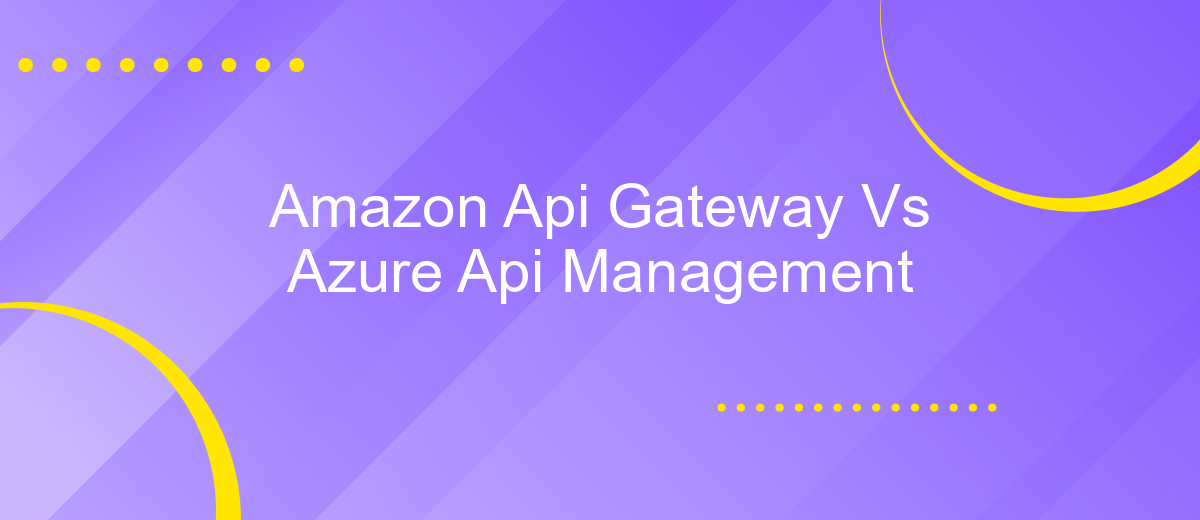Amazon Api Gateway Vs Azure Api Management
In the rapidly evolving landscape of cloud computing, choosing the right API management solution is crucial for seamless integration and efficient operations. This article delves into a comparative analysis of Amazon API Gateway and Azure API Management, two leading services that offer robust features for managing APIs. By examining their capabilities, pricing, and ease of use, we aim to provide insights to help you make an informed decision.
Overview
Amazon API Gateway and Azure API Management are two leading solutions for managing APIs. Both platforms offer robust features for creating, deploying, and monitoring APIs, but they cater to different needs and preferences. While Amazon API Gateway is tightly integrated with AWS services, Azure API Management excels in providing a comprehensive suite of tools for API lifecycle management within the Azure ecosystem.
- Amazon API Gateway: Seamless integration with AWS, cost-effective for low traffic, and easy to scale.
- Azure API Management: Advanced analytics, developer portal, and versatile policy configurations.
Choosing between these two services depends on your specific requirements and existing infrastructure. If you are already using AWS, Amazon API Gateway might be the more natural choice. Conversely, if your operations are centered around Azure, their API Management service could offer more streamlined integration. For those seeking additional customization, services like ApiX-Drive can further enhance your API workflows by automating integrations and simplifying data transfers between different platforms.
Pricing

When comparing pricing between Amazon API Gateway and Azure API Management, it's important to consider the different pricing models and what each service includes. Amazon API Gateway charges based on the number of API calls, data transfer out, and additional features such as caching. The pay-as-you-go model allows for flexibility but can become costly with high traffic volumes. Additionally, there are costs associated with custom domain names and usage plans, which need to be factored into the overall pricing.
Azure API Management, on the other hand, offers a tiered pricing model that includes Developer, Basic, Standard, and Premium tiers. Each tier comes with a fixed monthly fee and includes a certain number of API calls, with overage charges applying if the call limit is exceeded. The higher tiers provide additional features such as multi-region deployment and advanced security options. For businesses looking to integrate these services with other applications, tools like ApiX-Drive can help streamline the process, offering automated workflows and reducing the need for manual intervention.
Features

When comparing Amazon API Gateway and Azure API Management, it's essential to understand the features that each platform offers to developers and businesses. Both services provide robust tools for API creation, management, and monitoring, but they have unique characteristics that set them apart.
- Scalability: Amazon API Gateway offers automatic scaling to handle varying traffic loads, while Azure API Management provides built-in scaling options to manage API usage effectively.
- Security: Both platforms offer strong security features, including OAuth 2.0, API keys, and custom authorizers. However, Azure API Management also integrates with Azure Active Directory for enhanced security management.
- Monitoring and Analytics: Amazon API Gateway includes CloudWatch for monitoring and logging, whereas Azure API Management offers detailed analytics and insights through Azure Monitor.
- Integration: Amazon API Gateway integrates seamlessly with AWS services, while Azure API Management supports integration with Azure services and third-party tools like ApiX-Drive for streamlined workflows.
Ultimately, the choice between Amazon API Gateway and Azure API Management depends on your specific needs and existing infrastructure. Both platforms provide powerful features to ensure efficient API management and integration, enhancing overall productivity and security.
Security

When it comes to security, both Amazon API Gateway and Azure API Management offer robust features to protect your APIs. Amazon API Gateway provides multiple layers of security, including AWS Identity and Access Management (IAM) for controlling access, and Amazon Cognito for user authentication. Additionally, it supports API keys, AWS WAF for protection against common web exploits, and SSL/TLS encryption for data in transit.
Azure API Management also excels in security, offering features such as Azure Active Directory (AAD) integration for identity management and role-based access control (RBAC). It supports OAuth 2.0, OpenID Connect, and client certificates for secure API access. Azure API Management also includes built-in policies for IP filtering, rate limiting, and quotas to prevent abuse and ensure fair usage.
- Access control: IAM (AWS) vs. AAD and RBAC (Azure)
- Authentication: Cognito (AWS) vs. OAuth 2.0 and OpenID Connect (Azure)
- Protection: AWS WAF (AWS) vs. IP filtering and rate limiting (Azure)
- Encryption: SSL/TLS (both)
Both platforms also support integration with third-party services like ApiX-Drive, which can help automate and streamline API security configurations. Choosing between Amazon API Gateway and Azure API Management will depend on your specific security requirements and existing infrastructure.
Managed vs Serverless
When comparing Amazon API Gateway and Azure API Management, one crucial aspect to consider is the managed versus serverless approach. Amazon API Gateway is primarily serverless, meaning it allows developers to build, deploy, and manage APIs without worrying about the underlying infrastructure. This serverless nature ensures automatic scaling, high availability, and a pay-as-you-go pricing model, making it an ideal choice for applications with unpredictable traffic patterns. On the other hand, Azure API Management offers a managed service approach, providing a robust set of features like API versioning, rate limiting, and detailed analytics. This makes it suitable for enterprises requiring comprehensive API lifecycle management and tighter control over their API infrastructure.
Both platforms offer integration capabilities, but the choice between managed and serverless depends on specific use cases. For instance, if you need a quick and easy way to integrate various services and automate workflows, you might consider using a third-party tool like ApiX-Drive. ApiX-Drive can help streamline the integration process by connecting your APIs with other services effortlessly, regardless of whether you choose Amazon API Gateway or Azure API Management. Ultimately, the decision hinges on your project's scalability needs, budget, and desired level of control over API operations.


FAQ
What are the primary differences between Amazon API Gateway and Azure API Management?
How do pricing models differ between Amazon API Gateway and Azure API Management?
Which service offers better support for hybrid cloud environments?
Can both services handle large-scale API requests and traffic?
What are some automation tools that can help with API integration and management?
Apix-Drive is a universal tool that will quickly streamline any workflow, freeing you from routine and possible financial losses. Try ApiX-Drive in action and see how useful it is for you personally. In the meantime, when you are setting up connections between systems, think about where you are investing your free time, because now you will have much more of it.

